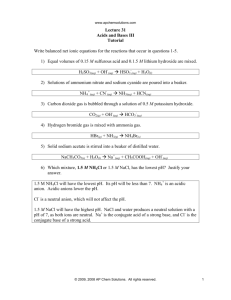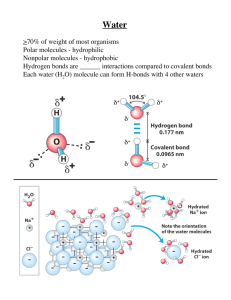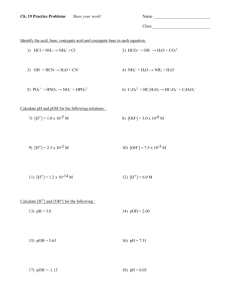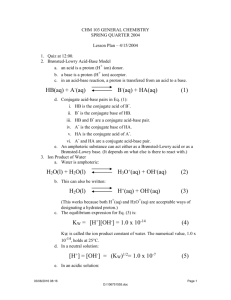16.3ab equil law-Ka
advertisement
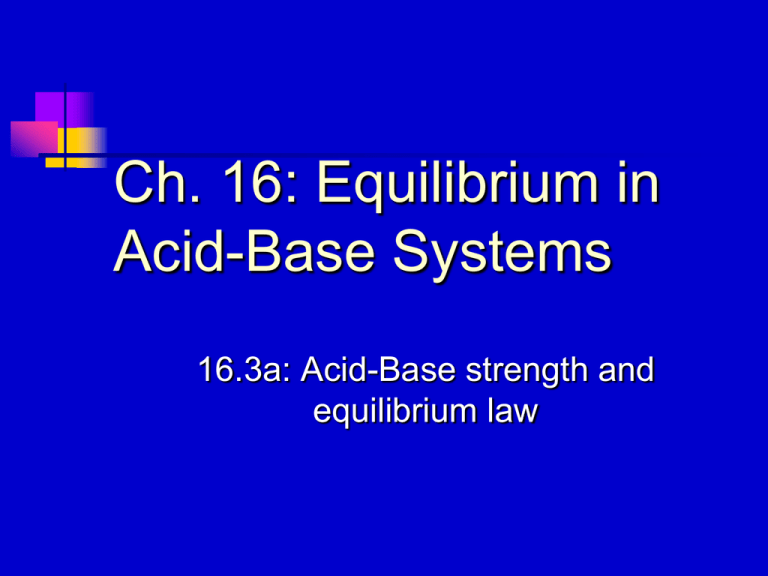
Ch. 16: Equilibrium in Acid-Base Systems 16.3a: Acid-Base strength and equilibrium law Definitions Arrhenius A: produce H+ in aqueous solution B: produces OH- in aqueous solution very limited Bronsted-Lowry A: H+ donor B: H+ acceptor more general Acid ionization constant equilibrium expression where H+ is removed to form conjugate base so for: HA + H2O <--> H3O+ + A- [ H 3O ][ A ] [ H ][ A ] Ka [ HA] [ HA] Strength determined by equilibrium position of dissociation reaction strong acid: lies far to right, almost all HA is dissociated large Ka values creates weak conjugate base weak acid: lies far to left, almost all HA stays as HA small Ka values creates strong conjugate base Water is a stronger base than the CB of a strong acid but a weaker base than the CB of a weak acid Water is a stronger acid than the CA of a strong base but a weaker acid than the CA of a weak base [H2O], pH and Kw conc. of liquid water is omitted from the Ka expression we assume that this conc. will remain constant in aqueous sol’n that are not highly concentrated pH= -log[H+] pOH = -log[OH-] 14.00= pH + pOH K w [ H 3O ][OH ] 1.0 10 14 Example 1 The [OH-] of a solution at 25oC is 1.0x10-5 M. Determine the [H+], pH and pOH. Kw = 1.0x10-14 = [OH-] x [H+] [H+] = 1.0x10-9 pH= -log(1.0x10-9) = 9.00 pOH = -log(1.0x10-5) = 5.00 acidic or basic? basic Approximations If K is very small, we can assume that the change (x) is going to be negligible “rule of thumb” is if initial conc. of the acid is >1000 times its Ka value then cancel x this makes the answer true to +/- 5% and why Ka values are given to 2 sig. digs 2 2 ( x)( 2 x) 0 ( x)( 2 x) 3 K 4x 2 2 (1.0 2 x) (1.0) Calculating Weak Acids 1. 2. 3. 4. 5. 6. Write major species Decide on which can provide H+ ions Make ICE table Put equilibrium values in Ka expression Check validity of assumption (x must be less than 5% of initial conc) Find pH Example 2 Calculate the pH of 1.00 M solution of HF (Ka = 7.2 x 10-4) HF, H2O + HF H + F Ka = 7.2x10-4 + H2O H + OH Kw = 1.0 x 10-14 + HF will provide much more H than H2O – ignore H2O HF Example 2 H+ F- + I 1.00 M 0 0 C -x +x +x E 1.00 -x x x 2 [ F ][ H ] ( x)( x) x 4 Ka 7.2 10 [ HF ] 1.00 x 1.00 x 7.2 10 2 4 x 0.027 M Example 2 Check assumption: x 100 5% [ HA] 0.027 100 2.7% 5% 1.00 pH = -log(0.027) = 1.57 Example 3 Find pH of 0.100 M solution of HOCl (Ka = 3.5x10-8) HOCl, H2O + HOCl will provide much more H than H2O, so we ignore H 2O HOCl H+ + OCl- I 0.100 M 0 0 C -x +x +x E 0.100 -x x x Example 3 2 [OCl ][ H ] ( x)( x) x 8 Ka 3.5 10 [ HOCl ] 0.100 x 0.100 9 5 x 3.5 10 x 5.9 10 M 2 Check assumption: 5 5.9 10 100 0.059% 5% 0.100 pH = -log(5.9x10-5) = 4.23 Homework Textbook p743 #2a,c,e 5,7,9 LSM 16.3A and 16.3D Ch. 16: Equilibrium in Acid-Base Systems 16.3b: Base strength and equilibrium law Base Strength and Kb follows same standard rules as for calculating Ka for acids Kb is used with weak bases that react only partially with water (<50%) Bases Kb base ionization constant refers to reaction of base with water to make conjugate acid and OHliquid water is again ignored like in Ka B(aq) + H2O (l) BH+ (aq) + OH- (aq) [ BH ][OH ] Kb [ B] Example 4 Find the pH for 15.0 M solution of NH3 (Kb = 1.8x10-5) NH3 will create more OH- than water so self- ionization (H2O) can be ignored NH3 + H2O <--> NH4+ + OHNH3 + H2O NH4+ + OH- I 15.0 0 0 C -x +x +x E 15.0-x x x Example 4 con’t 2 [ x][ x] x 5 Kb 1.8 10 [15.0 x] 15.0 x 0.016 % ion. 0.016 100 0.11% 5% 15.0 x [OH ] 0.016M 14 1.0 10 13 [H ] 6.2 10 0.016 13 pH log(6.2 10 ) 12.20 Example 5 Codeine (C18H21NO3) is a weak organic base. A 5.0x10-3 M solution of codeine has a pH of 9.95. Calculate the Kb for this substance. Sol’n What is chemical reaction? C18H21NO3 + H2O <--> HC18H21NO3+ + OHFind [OH-] using given pH pOH= 14.00-9.95 = 4.05 [OH-] = 10-4.05 = 8.9x10-5 Example 5 con’t C18H21NO3 + H O<--> HC18H21NO3+ + 2 5.0x10-3 -x 5.0x10-3 - x I C E 0 +x x OH0 +x x x = [OH-] = 8.9x10-5 [ x][ x] [8.9 10 5 ]2 Kb -3 -3 5 [5.0x10 x] [5.0x10 8.9 10 ] K b 1.6 10 6 Ka - Kb relationship for conjugate pairs Acid-Base strength tables do not give Kb values we use the Ka - Kb relationship to solve this problem this can be used with any conjugate acid-base pair Kw = Ka x Kb or Kb = Kw / Ka Kw = 1.0 x 10-14 Example 6 What is the Kb value for the weak base present when sodium cyanide dissociates into an aqueous solution? NaCN --> Na+ + CN- (complete dissociation) the CN- is the weak base so we write the equilibrium equation with water to determine its conjugate acid CN- + H2O <--> HCN + OHthe conjugate acid is found to be HCN and its Ka is 6.2 x 10-10 Using Kb = Kw / Ka find Kb for CNKb = 1 x 10-14 / 6.2 x 10-10 = 1.61 x 10-5 Homework Textbook p746 #11,12 Textbook p750 #2,6,9 LSM 16.3 A,B & D
